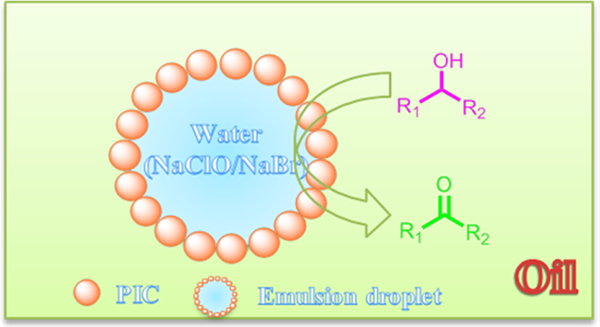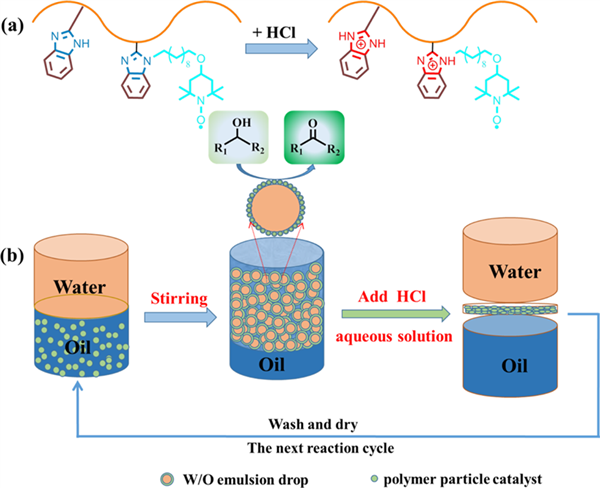TEMPO-Functionalized Aromatic Polymer as a Highly Active, pH Responsive Polymeric Interfacial Catalyst for Alcohol Oxidation
作者:Kecheng Hu, Jun Tang, Shixiong Cao, Qi Zhang, Jianli Wang*, and Zhibin Ye*
关键字:TEMPO, pH responsive polymeric interfacial catalyst, pickering emulsion
论文来源:期刊
具体来源:The Journal of Physical Chemistry C
发表时间:2019年

通过将2,2,6,6-四甲基哌啶-N-氧化物(TEMPO)一步接枝到具有苯并咪唑基团的聚芳醚酮(SCBI-PAEK-6F)上,设计合成了一种pH响应性聚合物界面催化剂(PIC)。并用1H核磁共振、傅里叶变换红外光谱、元素分析、接触角和透射电镜对聚合物进行了系统的表征。这种精心设计的聚合物已经应用于Montanari条件下的醇的氧化。这种功能化聚合物可在水-油界面聚集并充当有效稳定剂以促进稳定的Pickering乳液形成,其通过微反应器机理对醇的氧化反应表现出优异的催化活性。此外,由于苯并咪唑基团的存在,PIC具有较好的pH响应性。我们通过简单地将体系pH值调节至3,就可以实现Pickering乳液反应体系的去乳化,从而促进PIC回收。此外,可持续催化剂可以在随后的醇氧化循环中重复使用,且催化活性或选择性没有明显的损失。
We report in this paper the design and synthesis of a pH responsive polymeric interfacial catalyst (PIC) via one-step grafting of 2,2,6,6-tetramethylpiperidine-N-oxyl (TEMPO) onto a polyaryletherketone having pendant benzimidazole groups (SCBI-PAEK-6F). The TEMPO-functionalized polymer has been systematically characterized with 1H nuclear magnetic resonance, Fourier-transform infrared spectroscopy, elemental analysis, contact angle, and transmission electron microscopy. Moreover, this well-designed polymer has been applied in the oxidation of alcohols under Montanari conditions. It is found that the functionalized polymer can aggregate at the water-oil interface and act as an efficient stabilizer to facilitate the formation of a stable Pickering emulsion, which shows outstanding catalytic activity for alcohol oxidation through the microreactor mechanism. Moreover, the PIC is featured with desirable high pH responsiveness due to the valuable benzimidazole groups. De-emulsification of the Pickering emulsion reaction system can be conveniently triggered by simply tuning the system pH value to 3, thus facilitating the facile recovery of the PIC. In addition, the sustainable catalyst can be reused for subsequent cycles of alcohol oxidation without appreciable loss in catalytic activity or selectivity.

DOI: 10.1021/acs.jpcc.9b00467